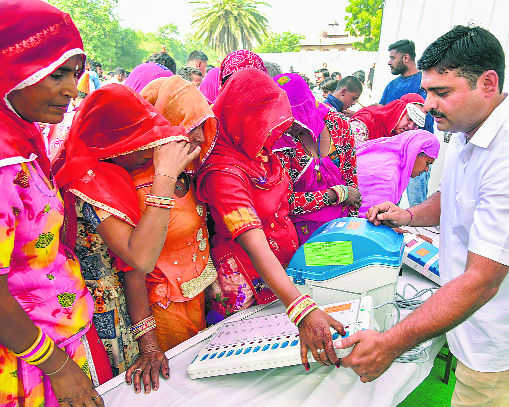
Count: About 3,300 EVMs, on an average, are used in each constituency of India.
Atanu Biswas
Professor, Indian Statistical Institute, Kolkata
WHETHER to use paper ballot or EVMs (electronic voting machines) for the electoral exercise in India is being hotly debated upon. For the time being, it is clear that EVMs will be used in the country. However, building confidence among the voters regarding the credibility of EVMs is no less important for democracy than to make the machines tamper-proof. This can easily be ensured by a proper statistical verification process.
Almost all EVMs in the country are now equipped with the Voter-Verifiable Paper Audit Trail (VVPAT). The VVPAT can be counted and tallied with the EVM count, and a perfect match is certainly a proof that the particular machine has not been tampered with. The key question is: how many EVMs are to be VVPAT-audited? In a press note dated May 20, 2017, the Election Commission of India (ECI) said: “The ECI will count VVPAT slips up to a definite percentage, which will be determined by the Commission.” During the 2017 Gujarat Assembly elections, the VVPATs for one EVM per constituency were counted, which was about 0.36 per cent of the total number of EVMs. In stark contrast, in a joint petition submitted last month, 21 political parties demanded 50 per cent VVPATs to be counted and tallied with the corresponding EVM count.
If we count too much, it would defeat the main purpose of using EVMs — to reduce time and effort as well as to curb electoral fraud. On the other hand, if we count an inadequate number of EVMs, doubts about the correctness of the election results persist among the voters and the political parties. This is not a desirable scenario for democracy. Thus, we need to balance — using appropriate statistical methodology — sampling and probability calculations.
Certainly, the number of EVMs to be VVPAT-audited should depend on the anticipated proportion of tampered EVMs, and also on the level of accuracy we would like to have in our procedure. The number of EVMs per constituency varies a lot due to the complex demographic pattern across the country. About 18 lakh EVMs are used all over India in 543 Lok Sabha constituencies, which means that there are slightly more than 3,300 machines per constituency, on an average.
Can we treat ‘99.9 per cent statistical assurance’ that the EVMs of a constituency were not tampered with to be enough? Assuming so, let’s see how many EVMs are to be VVPAT-audited in that case. If 50 per cent of the machines are tampered with, at least one EVM-VVPAT mismatch would be obtained with 99.9 per cent probability in a random sample of only 10 EVMs (which is 0.3 per cent of 3,300). If we assume that 20 per cent of the EVMs are tampered with, we would need manual checking of 31 EVMs (less than 1 per cent) to find at least one mismatch with 99.9 per cent probability. The number of EVM-VVPAT tallying needed would rise to 66 (2 per cent), 135 (4.1 per cent) or 342 (10.4 per cent) if 10 per cent, 5 per cent or 2 per cent EVMs are tampered with, respectively.
How will the problem of fixing the exact number of EVMs to be counted in each constituency be solved? Although the number of votes cast in an EVM would vary widely, we can consider an average for an illustration.
First, let’s have the ‘provisional’ results based on EVM counting. Let’s then categorise the constituencies based on the winning margins, say, (i) less than 1,000 votes; (ii) 1,001-5,000; (iii) 5,001-10,000; (iv) 10,001-20,000; (v) 20,001-30,000; and so on, and finally (xiii) more than 1 lakh. Now, assuming that about 400 votes can be altered on an average if an EVM is tinkered with, tampering one EVM might be enough in case (i). And one needs to tamper at least 3, 13, 25, 50,..., 250 EVMs to alter the result for cases (ii)-(xiii) — the result will not be altered if the number of tampered EVMs are less than these. One certainly needs 100 per cent EVMs to be VVPAT-audited in cases (i)-(ii). The number of EVMs to be tallied with the VVPAT count for the other cases are: (iii) 1,768 (53.6 per cent), (iv) 908 (27.5 per cent), (v) 453 (13.7 per cent),..., (xiii) 88 (2.7 per cent).
Determining the number of votes that can be manipulated by tampering one EVM separately for each constituency, the number of EVMs to be VVPAT-audited in each constituency separately after obtaining the ‘provisional’ EVM-based election result, and the ‘random’ selection of EVMs to be VVPAT-audited — all this should be done by statistical experts, who could be appointed for the purpose by the authorities concerned.
In any case, we would count VVPATs of a very small proportion of EVMs — varying numbers in different constituencies, and would be able to provide enough scientific evidence about the correctness of the voting machines.



























